Giuseppe Stragapede
KVC-onGoing: Keystroke Verification Challenge
Dec 29, 2024



Abstract:This article presents the Keystroke Verification Challenge - onGoing (KVC-onGoing), on which researchers can easily benchmark their systems in a common platform using large-scale public databases, the Aalto University Keystroke databases, and a standard experimental protocol. The keystroke data consist of tweet-long sequences of variable transcript text from over 185,000 subjects, acquired through desktop and mobile keyboards simulating real-life conditions. The results on the evaluation set of KVC-onGoing have proved the high discriminative power of keystroke dynamics, reaching values as low as 3.33% of Equal Error Rate (EER) and 11.96% of False Non-Match Rate (FNMR) @1% False Match Rate (FMR) in the desktop scenario, and 3.61% of EER and 17.44% of FNMR @1% at FMR in the mobile scenario, significantly improving previous state-of-the-art results. Concerning demographic fairness, the analyzed scores reflect the subjects' age and gender to various extents, not negligible in a few cases. The framework runs on CodaLab.
Type2Branch: Keystroke Biometrics based on a Dual-branch Architecture with Attention Mechanisms and Set2set Loss
May 02, 2024



Abstract:In 2021, the pioneering work on TypeNet showed that keystroke dynamics verification could scale to hundreds of thousands of users with minimal performance degradation. Recently, the KVC-onGoing competition has provided an open and robust experimental protocol for evaluating keystroke dynamics verification systems of such scale, including considerations of algorithmic fairness. This article describes Type2Branch, the model and techniques that achieved the lowest error rates at the KVC-onGoing, in both desktop and mobile scenarios. The novelty aspects of the proposed Type2Branch include: i) synthesized timing features emphasizing user behavior deviation from the general population, ii) a dual-branch architecture combining recurrent and convolutional paths with various attention mechanisms, iii) a new loss function named Set2set that captures the global structure of the embedding space, and iv) a training curriculum of increasing difficulty. Considering five enrollment samples per subject of approximately 50 characters typed, the proposed Type2Branch achieves state-of-the-art performance with mean per-subject EERs of 0.77% and 1.03% on evaluation sets of respectively 15,000 and 5,000 subjects for desktop and mobile scenarios. With a uniform global threshold for all subjects, the EERs are 3.25% for desktop and 3.61% for mobile, outperforming previous approaches by a significant margin.
IEEE BigData 2023 Keystroke Verification Challenge (KVC)
Jan 29, 2024Abstract:This paper describes the results of the IEEE BigData 2023 Keystroke Verification Challenge (KVC), that considers the biometric verification performance of Keystroke Dynamics (KD), captured as tweet-long sequences of variable transcript text from over 185,000 subjects. The data are obtained from two of the largest public databases of KD up to date, the Aalto Desktop and Mobile Keystroke Databases, guaranteeing a minimum amount of data per subject, age and gender annotations, absence of corrupted data, and avoiding excessively unbalanced subject distributions with respect to the considered demographic attributes. Several neural architectures were proposed by the participants, leading to global Equal Error Rates (EERs) as low as 3.33% and 3.61% achieved by the best team respectively in the desktop and mobile scenario, outperforming the current state of the art biometric verification performance for KD. Hosted on CodaLab, the KVC will be made ongoing to represent a useful tool for the research community to compare different approaches under the same experimental conditions and to deepen the knowledge of the field.
Keystroke Verification Challenge (KVC): Biometric and Fairness Benchmark Evaluation
Nov 10, 2023



Abstract:Analyzing keystroke dynamics (KD) for biometric verification has several advantages: it is among the most discriminative behavioral traits; keyboards are among the most common human-computer interfaces, being the primary means for users to enter textual data; its acquisition does not require additional hardware, and its processing is relatively lightweight; and it allows for transparently recognizing subjects. However, the heterogeneity of experimental protocols and metrics, and the limited size of the databases adopted in the literature impede direct comparisons between different systems, thus representing an obstacle in the advancement of keystroke biometrics. To alleviate this aspect, we present a new experimental framework to benchmark KD-based biometric verification performance and fairness based on tweet-long sequences of variable transcript text from over 185,000 subjects, acquired through desktop and mobile keyboards, extracted from the Aalto Keystroke Databases. The framework runs on CodaLab in the form of the Keystroke Verification Challenge (KVC). Moreover, we also introduce a novel fairness metric, the Skewed Impostor Ratio (SIR), to capture inter- and intra-demographic group bias patterns in the verification scores. We demonstrate the usefulness of the proposed framework by employing two state-of-the-art keystroke verification systems, TypeNet and TypeFormer, to compare different sets of input features, achieving a less privacy-invasive system, by discarding the analysis of text content (ASCII codes of the keys pressed) in favor of extended features in the time domain. Our experiments show that this approach allows to maintain satisfactory performance.
Exploring Transformers for On-Line Handwritten Signature Verification
Jul 06, 2023


Abstract:The application of mobile biometrics as a user-friendly authentication method has increased in the last years. Recent studies have proposed novel behavioral biometric recognition systems based on Transformers, which currently outperform the state of the art in several application scenarios. On-line handwritten signature verification aims to verify the identity of subjects, based on their biometric signatures acquired using electronic devices such as tablets or smartphones. This paper investigates the suitability of architectures based on recent Transformers for on-line signature verification. In particular, four different configurations are studied, two of them rely on the Vanilla Transformer encoder, and the two others have been successfully applied to the tasks of gait and activity recognition. We evaluate the four proposed configurations according to the experimental protocol proposed in the SVC-onGoing competition. The results obtained in our experiments are promising, and promote the use of Transformers for on-line signature verification.
TypeFormer: Transformers for Mobile Keystroke Biometrics
Dec 26, 2022



Abstract:The broad usage of mobile devices nowadays, the sensitiveness of the information contained in them, and the shortcomings of current mobile user authentication methods are calling for novel, secure, and unobtrusive solutions to verify the users' identity. In this article, we propose TypeFormer, a novel Transformer architecture to model free-text keystroke dynamics performed on mobile devices for the purpose of user authentication. The proposed model consists in Temporal and Channel Modules enclosing two Long Short-Term Memory (LSTM) recurrent layers, Gaussian Range Encoding (GRE), a multi-head Self-Attention mechanism, and a Block-Recurrent structure. Experimenting on one of the largest public databases to date, the Aalto mobile keystroke database, TypeFormer outperforms current state-of-the-art systems achieving Equal Error Rate (EER) values of 3.25% using only 5 enrolment sessions of 50 keystrokes each. In such way, we contribute to reducing the traditional performance gap of the challenging mobile free-text scenario with respect to its desktop and fixed-text counterparts. Additionally, we analyse the behaviour of the model with different experimental configurations such as the length of the keystroke sequences and the amount of enrolment sessions, showing margin for improvement with more enrolment data. Finally, a cross-database evaluation is carried out, demonstrating the robustness of the features extracted by TypeFormer in comparison with existing approaches.
IJCB 2022 Mobile Behavioral Biometrics Competition (MobileB2C)
Oct 06, 2022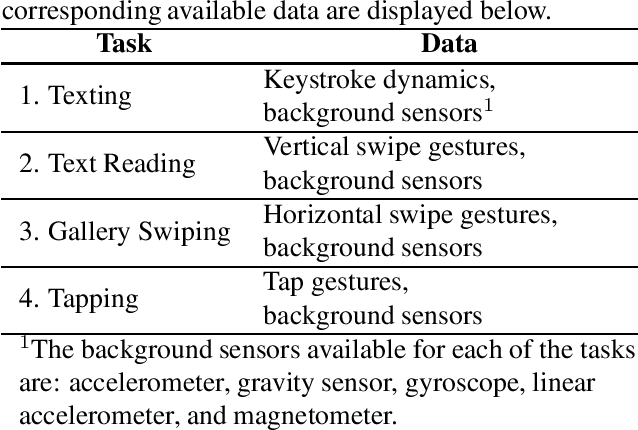
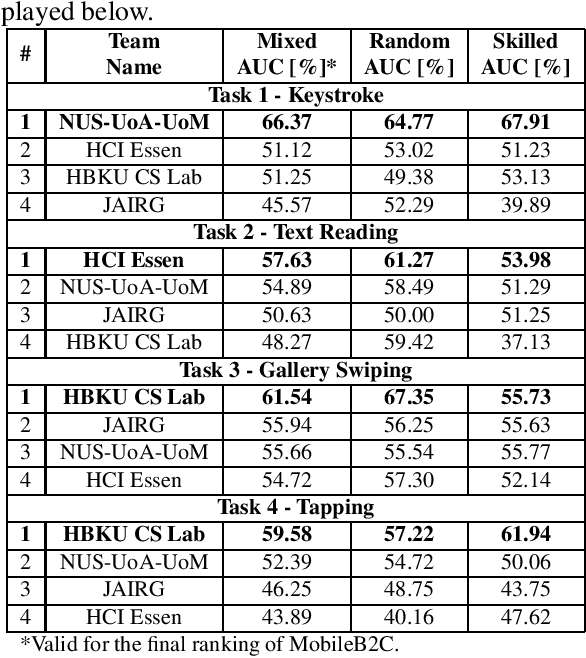
Abstract:This paper describes the experimental framework and results of the IJCB 2022 Mobile Behavioral Biometrics Competition (MobileB2C). The aim of MobileB2C is benchmarking mobile user authentication systems based on behavioral biometric traits transparently acquired by mobile devices during ordinary Human-Computer Interaction (HCI), using a novel public database, BehavePassDB, and a standard experimental protocol. The competition is divided into four tasks corresponding to typical user activities: keystroke, text reading, gallery swiping, and tapping. The data are composed of touchscreen data and several background sensor data simultaneously acquired. "Random" (different users with different devices) and "skilled" (different user on the same device attempting to imitate the legitimate one) impostor scenarios are considered. The results achieved by the participants show the feasibility of user authentication through behavioral biometrics, although this proves to be a non-trivial challenge. MobileB2C will be established as an on-going competition.
Mobile Keystroke Biometrics Using Transformers
Jul 15, 2022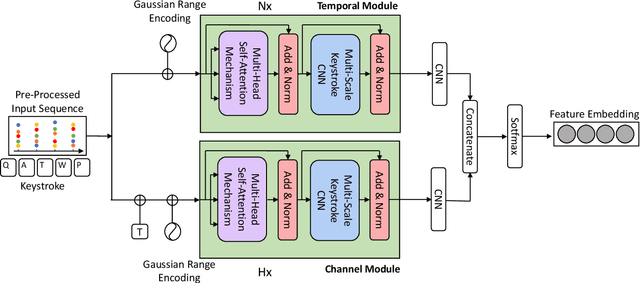
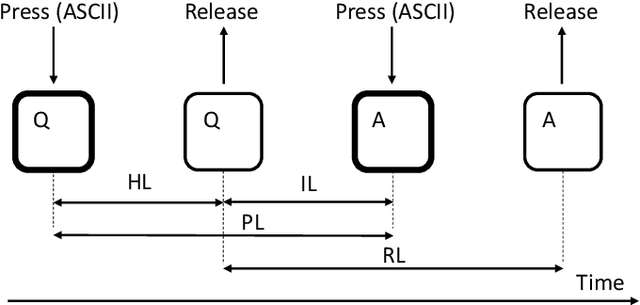
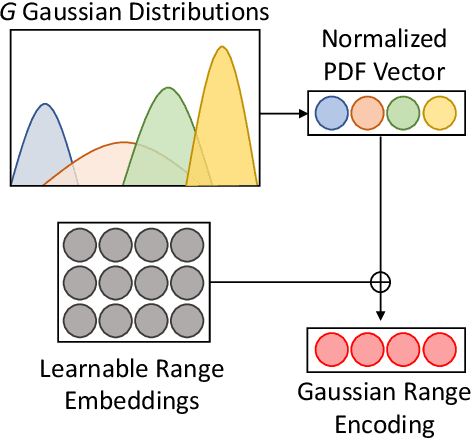

Abstract:Behavioural biometrics have proven to be effective against identity theft as well as be considered user-friendly authentication methods. One of the most popular traits in the literature is keystroke dynamics due to the large deployment of computers and mobile devices in our society. This paper focuses on improving keystroke biometric systems on the free-text scenario. This scenario is characterised as very challenging due to the uncontrolled text conditions, the influential of the user's emotional and physical state, and the in-use application. To overcome these drawbacks, methods based on deep learning such as Convolutional Neural Networks (CNNs) and Recurrent Neural Networks (RNNs) have been proposed in the literature, outperforming traditional machine learning methods. However, these architectures still have aspects that need to be reviewed and improved. To the best of our knowledge, this is the first study that proposes keystroke biometric systems based on Transformers. The proposed Transformer architecture has achieved Equal Error Rate (EER) values of 3.84% in the popular Aalto mobile keystroke database using only 5 enrolment sessions, outperforming in large margin other state-of-the-art approaches in the literature.
BehavePassDB: Benchmarking Mobile Behavioral Biometrics
Jun 06, 2022



Abstract:Mobile behavioral biometrics have become a popular topic of research, reaching promising results in terms of authentication, exploiting a multimodal combination of touchscreen and background sensor data. However, there is no way of knowing whether state-of-the-art classifiers in the literature can distinguish between the notion of user and device. In this article, we present a new database, BehavePassDB, structured into separate acquisition sessions and tasks to mimic the most common aspects of mobile Human-Computer Interaction (HCI). BehavePassDB is acquired through a dedicated mobile app installed on the subjects' devices, also including the case of different users on the same device for evaluation. We propose a standard experimental protocol and benchmark for the research community to perform a fair comparison of novel approaches with the state of the art. We propose and evaluate a system based on Long-Short Term Memory (LSTM) architecture with triplet loss and modality fusion at score level.
Mobile Behavioral Biometrics for Passive Authentication
Mar 14, 2022
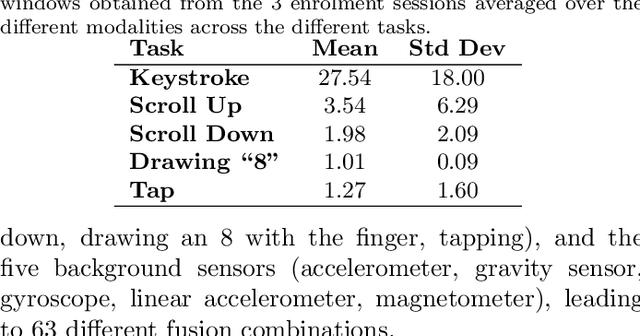

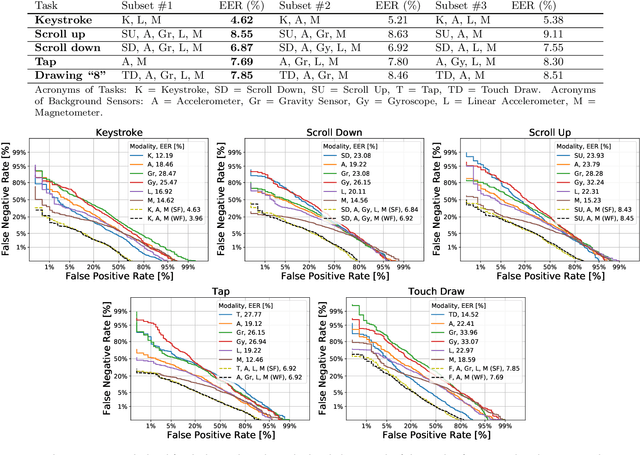
Abstract:Current mobile user authentication systems based on PIN codes, fingerprint, and face recognition have several shortcomings. Such limitations have been addressed in the literature by exploring the feasibility of passive authentication on mobile devices through behavioral biometrics. In this line of research, this work carries out a comparative analysis of unimodal and multimodal behavioral biometric traits acquired while the subjects perform different activities on the phone such as typing, scrolling, drawing a number, and tapping on the screen, considering the touchscreen and the simultaneous background sensor data (accelerometer, gravity sensor, gyroscope, linear accelerometer, and magnetometer). Our experiments are performed over HuMIdb, one of the largest and most comprehensive freely available mobile user interaction databases to date. A separate Recurrent Neural Network (RNN) with triplet loss is implemented for each single modality. Then, the weighted fusion of the different modalities is carried out at score level. In our experiments, the most discriminative background sensor is the magnetometer, whereas among touch tasks the best results are achieved with keystroke in a fixed-text scenario. In all cases, the fusion of modalities is very beneficial, leading to Equal Error Rates (EER) ranging from 4% to 9% depending on the modality combination in a 3-second interval.
 Add to Chrome
Add to Chrome Add to Firefox
Add to Firefox Add to Edge
Add to Edge